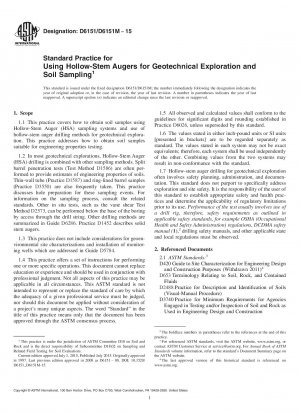ASTM D6151/D6151M-15
Standard Practice for Using Hollow-Stem Augers for Geotechnical Exploration and Soil Sampling
- Standard No.
- ASTM D6151/D6151M-15
- Release Date
- 2015
- Published By
- American Society for Testing and Materials (ASTM)
- Latest
- ASTM D6151/D6151M-15
- Scope
4.1 Hollow-stem augers are frequently used for geotechnical exploration. One reason they are used is that the method is considered a “dry” drilling method where drill fluids are not needed to advance the borehole in unstable formations. Often, hollow-stem augers are used with other sampling systems, such as split barrel penetration resistance testing, Test Method D1586, or thin-wall tube sampling, Practice D1587 (see 2.5). HSA may be used to advance a drill hole without sampling using a pilot bit assembly, or they may be equipped with a sampling system for obtaining soil cores. In some subsurface conditions that contain cohesive soils, the drillhole can be successfully advanced without the use of a pilot bit assembly. Intermittent drilling (advancing of the HSA column with or without a pilot bit) and sampling can be performed depending on the intervals to be sampled, or continuous sampling can be performed. During pauses in the drilling and sampling process, in situ testing or other soil sampling methods can be performed through the hollow auger column below the lead auger assembly. At completion of the boring to the depth of interest, the hole may be abandoned or testing or monitoring devices can be installed. Hollow-stem auger drilling allows for drilling and casing the hole simultaneously, thereby eliminating hole caving problems and contamination of soil samples (2). The hollow-stem auger drilling and sampling method can be a satisfactory means for collecting samples of shallow unconsolidated subsurface materials (2). Additional guidance on use can be found in Refs. 2, 3, 4, 5, 6.
4.2 Soil sampling with a double-tube hollow-stem sampling system provides a method for obtaining continuous or intermittent samples of soils for accurate logging of subsurface materials to support geotechnical testing and exploration. A wide variety of soils from clays to sands can be sampled. The sampling systems can be particularly effective in dry soft to stiff clayey or silty deposits but also can work well under saturated conditions. Saturated cohesionless soils such as clean sands may flow and cave during drilling (see Note 1). In many cases, the HSA soil core sampling system can produce very little disturbance to the sample and can provide samples for laboratory tests for measurement of selected engineering properties. Large-diameter soil cores, if taken carefully, can provide Class C and D samples as described in Practice D4220. The HSA systems can also provide disturbed samples of unsaturated sands and gravels with some structure preserved. Full 5-ft [1.5-m] long cores usually cannot be obtained in unsaturated sands due to increasing side wall friction between the dry sands and inside surface of the sample core barrel. Sample length of 2 to 2.5 ft. [0.60 to 0.75 m] is generally the limit of amount of sample that can be recovered in unsaturated sands before the friction between the sampler and the sand becomes too high and causes blocking or plugging of the sampler. Shorter large diameter core runs of 2.5 ft [0.75-m] with the 5-ft [1.5-m] sample barrel system, or with a 2.5-ft [0.75-m]......
ASTM D6151/D6151M-15 Referenced Document
- ASTM D1452 Standard Practice for Soil Investigation and Sampling by Auger Borings
- ASTM D1586 Standard Test Method for Penetration Test and Split-Barrel Sampling of Soils
- ASTM D1587 Standard Practice for Thin-Walled Tube Sampling of Soils for Geotechnical Purposes
- ASTM D2113 Standard Practice for Rock Core Drilling and Sampling of Rock for Site Investigation
- ASTM D2488 Recommended Practice for Description Of Soils (Visual-Manual Procedure)
- ASTM D2573 Standard Test Method for Field Vane Shear Test in Cohesive Soil
- ASTM D3441 Standard Test Method for Mechanical Cone Penetration Tests of Soil
- ASTM D3550 Standard Practice for Thick Wall, Ring-Lined, Split Barrel, Drive Sampling of Soils
- ASTM D3740 Standard Practice for Minimum Requirements for Agencies Engaged in the Testing and/or Inspection of Soil and Rock as Used in Engineering Design and Construction
- ASTM D420 Standard Guide to Site Characterization for Engineering Design and Construction Purposes
- ASTM D4220 Standard Practices for Preserving and Transporting Soil Samples
- ASTM D4428/D4428M Standard Test Methods for Crosshole Seismic Testing
- ASTM D4719 Standard Test Methods for Prebored Pressuremeter Testing in Soils
- ASTM D5092 Standard Practice for Design and Installation of Ground Water Monitoring Wells in Aquifers
- ASTM D5434 Standard Guide for Field Logging of Subsurface Explorations of Soil and Rock
- ASTM D5784 Standard Guide for Use of Hollow-Stem Augers for Geoenvironmental Exploration and the Installation of Subsurface Water-Quality Monitoring Devices
- ASTM D6026 Standard Practice for Using Significant Digits in Geotechnical Data
- ASTM D6286 Standard Guide for Selection of Drilling Methods for Environmental Site Characterization
- ASTM D653 Standard Terminology Relating to Soil, Rock, and Contained Fluids
ASTM D6151/D6151M-15 history
- 2015 ASTM D6151/D6151M-15 Standard Practice for Using Hollow-Stem Augers for Geotechnical Exploration and Soil Sampling
- 2008 ASTM D6151-08 Standard Practice for Using Hollow-Stem Augers for Geotechnical Exploration and Soil Sampling
- 1997 ASTM D6151-97(2003) Standard Practice for Using Hollow-Stem Augers for Geotechnical Exploration and Soil Sampling
- 1997 ASTM D6151-97 Standard Practice for Using Hollow-Stem Augers for Geotechnical Exploration and Soil Sampling

Copyright ©2024 All Rights Reserved